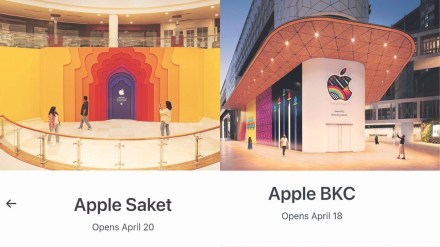The opening of the two Apple-owned stores in India last week set the proverbial cat among the pigeons. The two locations straightaway signalled that Interbrand’s Best Global Brand for 10 consecutive years wants full control over the consumer journey in India — from manufacturing to retail. The serpentine queues that waited for the store doors to open pointed at the importance consumers still attach to personalised interactions. When local retailers said they were jittery as these owned-stores could eat up a big chunk of their business, it brought home the role these stores are expected to play to expand the market.
Here’s the thing: Apple doesn’t consider its retail outlets as mere “stores” but an extension of the overall brand experience. And while the brand has been in India for over a quarter of a century, it has had no direct retail presence here until now. Overall this gives a positive spin to the Apple story in India, says angel investor & business strategist Lloyd Mathias. “The sheer traffic the stores will have in the first year or so would be great for the brand, just like it did for Ikea,” he adds.
Globally, Apple Store associates are trained to handhold customers through five distinct service steps — adapted from the Ritz-Carlton steps of service — that spells out the acronym ‘A-P-P-L-E’: A: Approach customers with a personalised, warm welcome; P: Probe politely to figure out her needs; P: Present a solution for her to take home today; L: Listen for and resolve issues or concerns; and finally, E: End with a fond farewell and an invitation to return.
Global model
Experts say the India stores will follow the international best practices.
Take location. Choosing two key cities for the store launch, says Mathias, is a positive demonstration that Apple is finally taking India as a serious market. “One of the big charms of visiting an Apple store, even if somebody is not inclined to buy a product, is exploring the range of products and interacting with its knowledgeable staff — both of which have a positive impact on the brand,” he says.
Now consider store ambience. Apple stores globally have set the bar quite high in terms of staff knowledge and expertise, and the services offered. For instance, areas within an Apple store are earmarked as music, fitness, smart homes, and other customer needs. There are fewer SKUs than available at other comparable large retailers so the store associates have fewer product details to memorise and customers are served better as a result.
Karan Taurani, senior VP, Elara Capital, notes that MNCs such as Netflix and Amazon have proved how hiring right makes all the difference. That has also helped expand the talent pool. No one sees HR as a big problem for Apple here.
But all that channel expertise might not be enough to swing the needle. India is predominantly an Android market and remains highly price-sensitive. Most other players have adopted the startegy to slash prices of top selling models at the fag end of their lives or when upgrades are introduced.
“The high-end consumer already has an Apple; once the middle end of the market moves up the ladder and grabs an Apple upgrade only then can the brand gain market share,” says Taurani.
As per Counterpoint Research India, India has been traditionally been a middle-heavy market, and the sweet spot has settled at the $200-$300 band. But the market $400-plus is also growing — from 4% of the total volumes before the pandemic it was almost 10% by the end of 2022. In terms of value, it comprises 35% of the total market, up from 15% in 2019. That’s a trend towards premiumisation, point out experts.
In other words, the home of 800 million mobile phone users has the potential to grow to more than a billion smartphone users in the next five years. Most of these users are upgrading to their second or third smartphones right now and being mobile first, consumers are spending and upgrading to better and more expensive smartphones.
While the opportunity is vast, the challenge for Apple would be to put in place facilities such as device financing and trade in, and bundling schemes attractive to reduce the barriers to entry into the Apple ecosystem for first-time iPhone users or the mid-tier to premium upgraders, says Tarun Pathak, research director, Counterpoint Technology Market Research.
